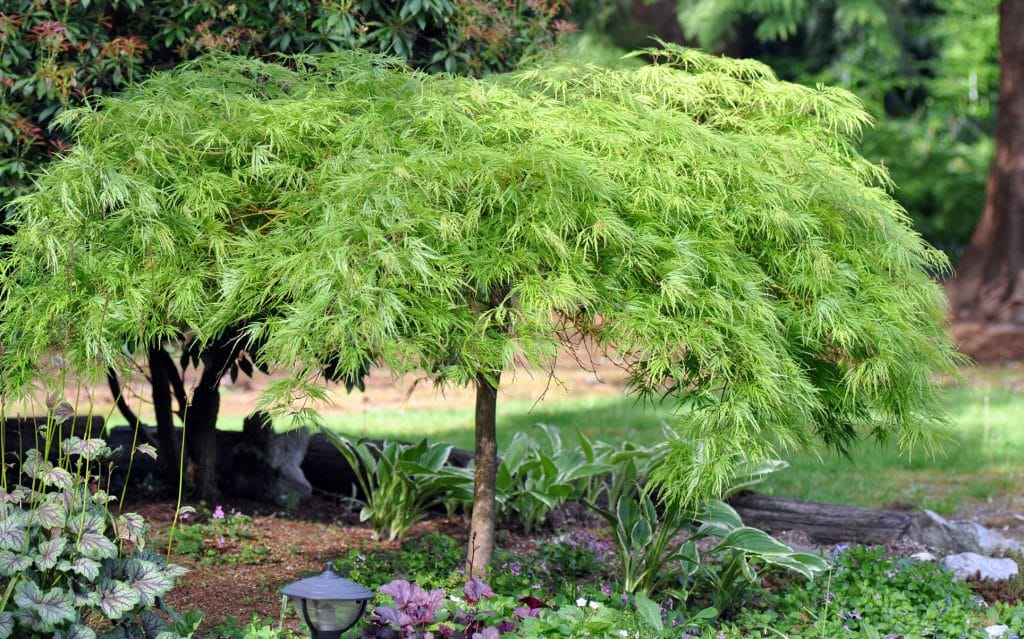Introduction
The Japanese maple (Acer palmatum) is a small to medium-sized deciduous tree native to Japan, Korea, and China. Known for its stunning seasonal changes and diverse forms, this tree has become a staple in gardens and landscapes globally. Its intricate, palmate leaves come in a variety of colors, ranging from vibrant reds and oranges to subtle greens and purples, depending on the season and variety.
Varieties of Japanese Maple
Japanese maples are celebrated for their wide range of cultivars, each with unique characteristics. Here are some popular varieties:
- Crimson Queen: Renowned for its deep red foliage that holds its color well throughout the season. It has a graceful, weeping form that adds a touch of elegance to any garden.
- Bloodgood: This variety is prized for its striking red leaves that turn a brilliant crimson in the fall. It is known for its strong, upright growth and dense canopy.
- Shishigashira: Often called the “Lion’s Head” maple, it features compact, curled leaves and a rounded growth habit. It’s ideal for smaller gardens or container planting.
- Katsura: Distinguished by its bright green leaves that turn a vibrant yellow and orange in the fall. It has a more open, spreading form that works well in larger spaces.
- Sango Kaku: Also known as the “Coral Bark” maple, it is famous for its striking coral-colored bark, which provides winter interest. Its leaves are a vibrant green that turns yellow in the fall.
Cultivation and Care
Cultivating Japanese maples requires attention to several key factors to ensure their health and beauty:
- Location: Japanese maples prefer a location with morning sun and afternoon shade. This helps protect their delicate leaves from scorching and enhances their color.
- Soil: They thrive in well-drained, slightly acidic soil. Incorporating organic matter into the soil can improve drainage and nutrient content.
- Watering: Regular watering is crucial, especially during dry spells. However, avoid overwatering, as Japanese maples are susceptible to root rot in waterlogged conditions.
- Pruning: Pruning is best done in late winter or early spring before new growth begins. Remove any dead or crossing branches to maintain an open canopy and encourage healthy growth.
- Fertilization: Feed Japanese maples with a balanced, slow-release fertilizer in early spring. Over-fertilizing can lead to excessive leaf growth and reduce the tree’s overall health.
- Pests and Diseases: Japanese maples can be prone to pests like aphids and scale insects, as well as diseases such as powdery mildew. Regular inspection and prompt treatment can help manage these issues.
Cultural Significance
In Japanese culture, the maple tree is more than just a beautiful plant; it holds deep symbolic meaning. The Japanese maple is often associated with the changing seasons, particularly autumn, when its leaves transform into a fiery palette of reds and oranges. This seasonal change is celebrated in Japanese gardens and traditional art, symbolizing the transient nature of life and the beauty of change.
The practice of “momijigari,” or maple leaf viewing, is a popular autumn tradition in Japan. People visit gardens, temples, and parks to admire the vibrant foliage and partake in outdoor activities. This practice mirrors the Japanese appreciation for the ephemeral beauty of nature, reflecting a deeper philosophical and cultural appreciation for the changing seasons.
Conclusion
The Japanese maple is a testament to the beauty and elegance of nature. Its diverse varieties, ease of cultivation, and cultural significance make it a cherished addition to gardens and landscapes. Whether you’re an experienced gardener or a novice enthusiast, the Japanese maple offers a timeless charm that can enhance any outdoor space.
Embracing the care and appreciation of Japanese maples allows you to experience the subtle grace and profound beauty of this remarkable tree. As you nurture and enjoy its vibrant foliage, you participate in a tradition that celebrates both the fleeting and enduring aspects of nature.
FAQs
1. How do I choose the right Japanese maple variety for my garden?
- Consider the size of your garden, the amount of sunlight it receives, and your preference for leaf color and shape. Smaller varieties like Shishigashira are great for limited spaces, while larger varieties like Bloodgood are suited for more expansive areas.
2. When is the best time to plant a Japanese maple?
- The best time to plant Japanese maples is in the spring or fall. This allows the tree to establish its roots before the heat of summer or the cold of winter.
3. Can Japanese maples be grown in containers?
- Yes, Japanese maples can thrive in containers. Ensure the container has adequate drainage and choose a variety that suits container life, such as the Shishigashira.
4. How often should I water my Japanese maple?
- Water regularly, especially during dry periods. The soil should be kept moist but not soggy. Adjust watering based on weather conditions and soil moisture.
5. What should I do if my Japanese maple has pest problems?
- Regularly inspect your tree for pests. If you notice issues, treat them promptly with appropriate pest control methods or consult a gardening expert for advice.








